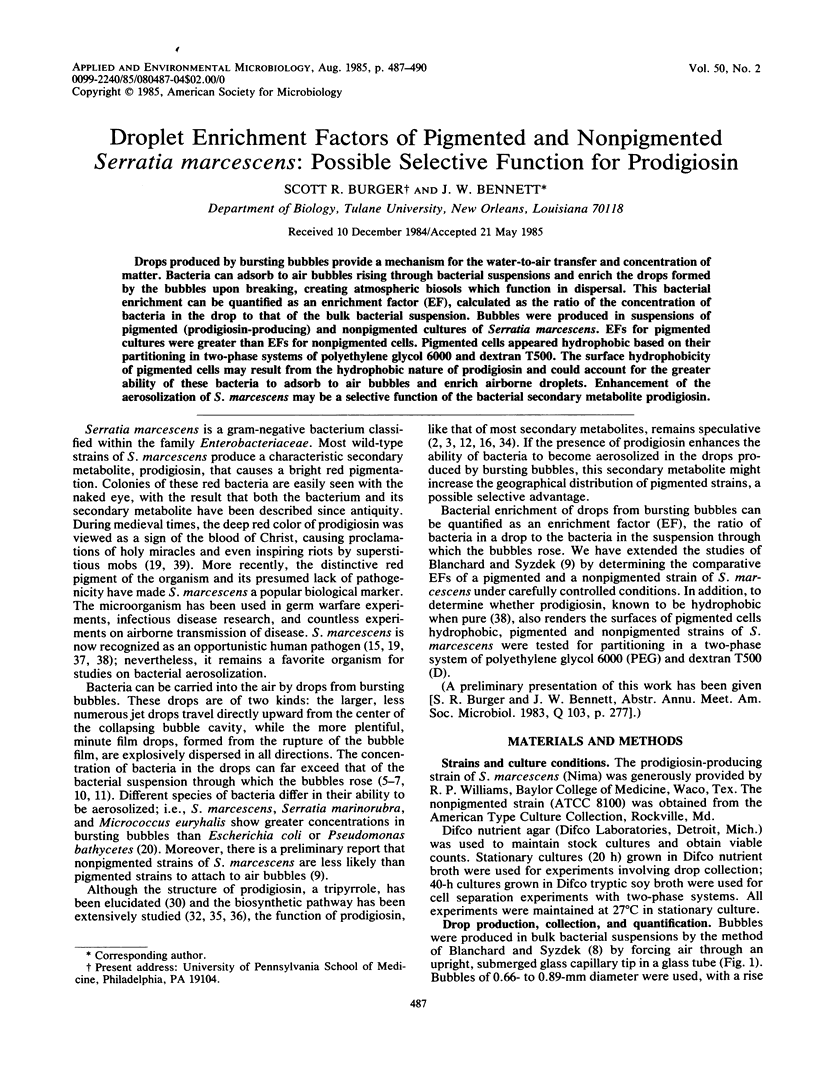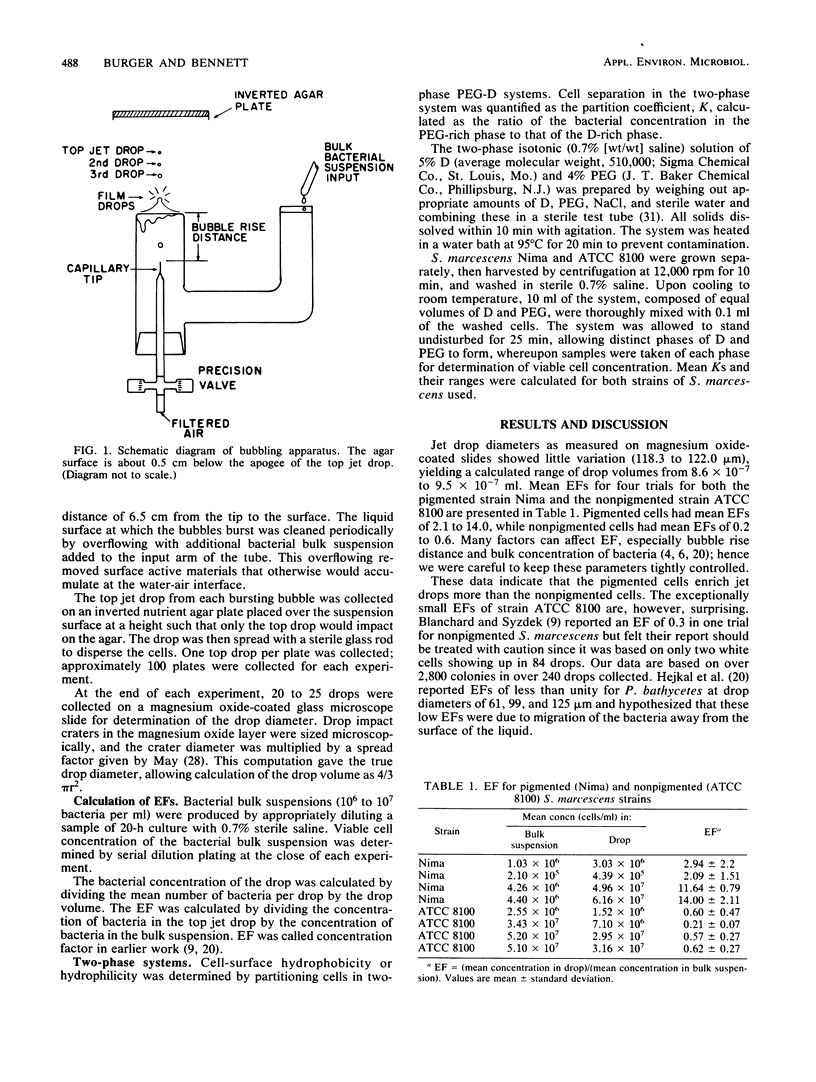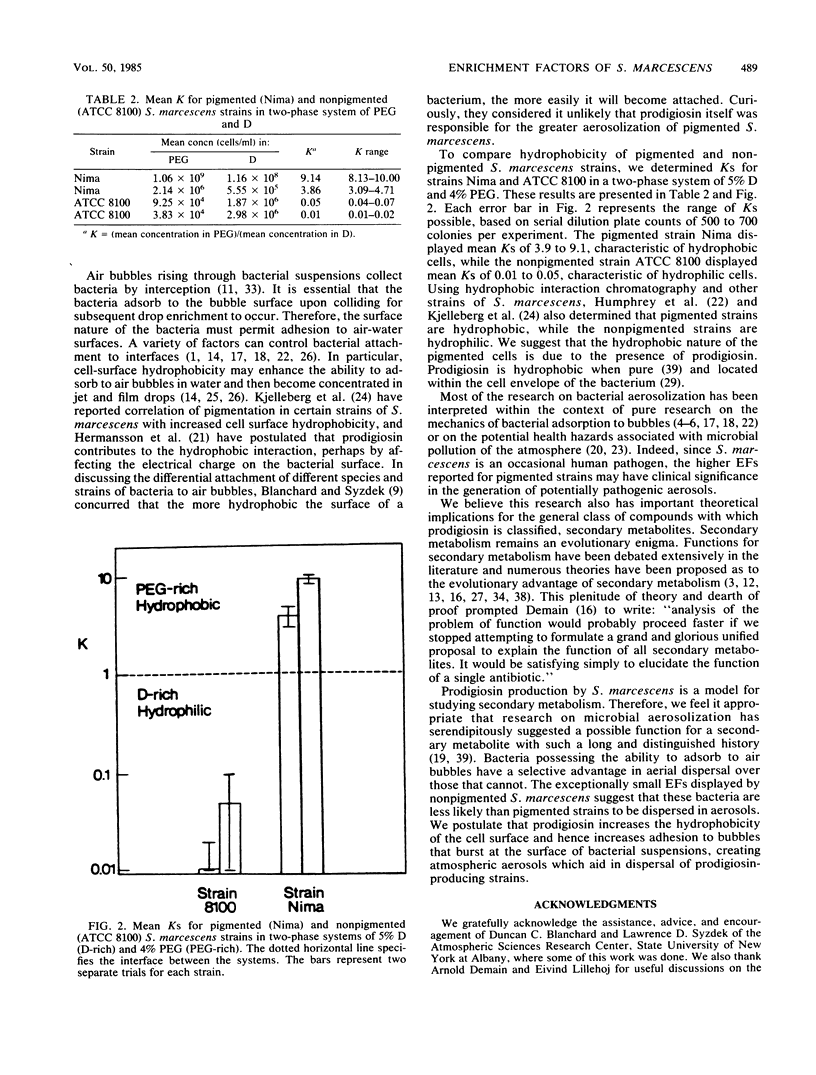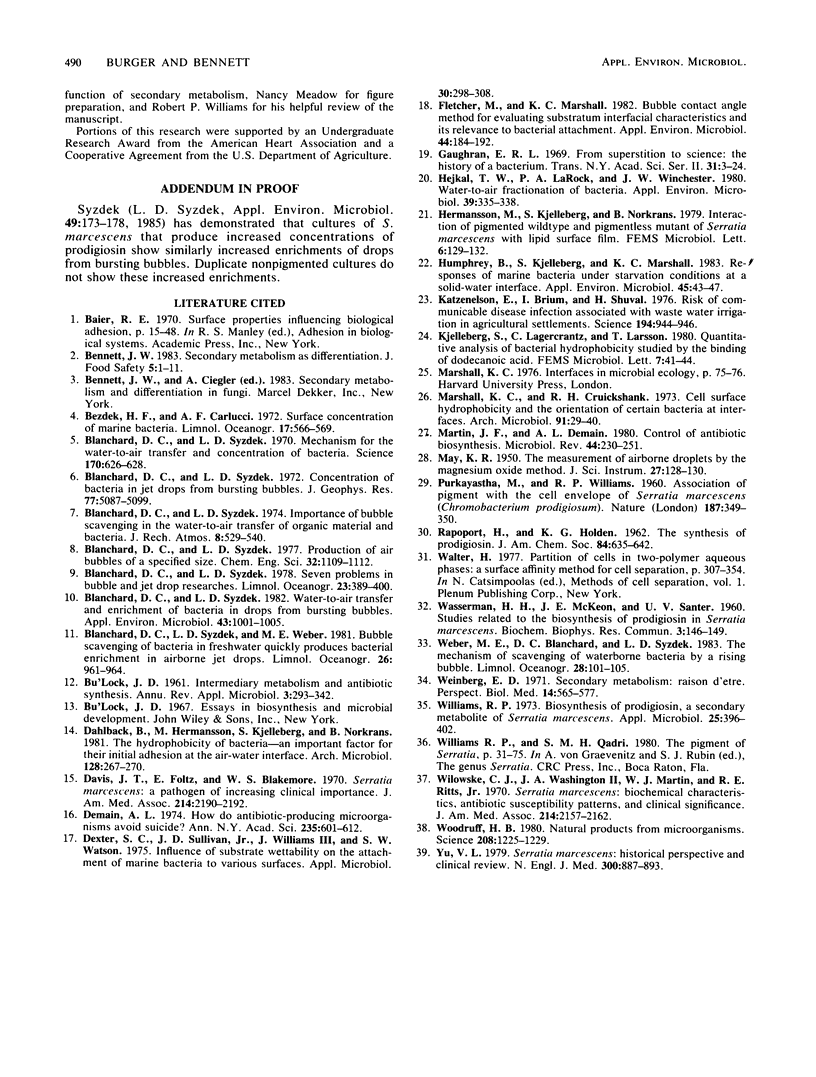Abstract
Drops produced by bursting bubbles provide a mechanism for the water-to-air transfer and concentration of matter. Bacteria can adsorb to air bubbles rising through bacterial suspensions and enrich the drops formed by the bubbles upon breaking, creating atmospheric biosols which function in dispersal. This bacterial enrichment can be quantified as an enrichment factor (EF), calculated as the ratio of the concentration of bacteria in the drop to that of the bulk bacterial suspension. Bubbles were produced in suspensions of pigmented (prodigiosin-producing) and nonpigmented cultures of Serratia marcescens. EFs for pigmented cultures were greater than EFs for nonpigmented cells. Pigmented cells appeared hydrophobic based on their partitioning in two-phase systems of polyethylene glycol 6000 and dextran T500. The surface hydrophobicity of pigmented cells may result from the hydrophobic nature of prodigiosin and could account for the greater ability of these bacteria to adsorb to air bubbles and enrich airborne droplets. Enhancement of the aerosolization of S. marcescens may be a selective function of the bacterial secondary metabolite prodigiosin.
Full text
PDF



Selected References
These references are in PubMed. This may not be the complete list of references from this article.
- BU'LOCK J. D. Intermediary metabolism and antibiotic synthesis. Adv Appl Microbiol. 1961;3:293–342. doi: 10.1016/s0065-2164(08)70514-8. [DOI] [PubMed] [Google Scholar]
- Blanchard D. C., Syzdek L. D. Water-to-Air Transfer and Enrichment of Bacteria in Drops from Bursting Bubbles. Appl Environ Microbiol. 1982 May;43(5):1001–1005. doi: 10.1128/aem.43.5.1001-1005.1982. [DOI] [PMC free article] [PubMed] [Google Scholar]
- Blanchard D. C., Syzdek L. Mechanism for the water-to-air transfer and concentration of bacteria. Science. 1970 Nov 6;170(3958):626–628. doi: 10.1126/science.170.3958.626. [DOI] [PubMed] [Google Scholar]
- Dahlbäck B., Hermansson M., Kjelleberg S., Norkrans B. The hydrophobicity of bacteria - an important factor in their initial adhesion at the air-water interface. Arch Microbiol. 1981 Jan;128(3):267–270. doi: 10.1007/BF00422527. [DOI] [PubMed] [Google Scholar]
- Davis J. T., Foltz E., Blakemore W. S. Serratia marcescens. A pathogen of increasing clinical importance. JAMA. 1970 Dec 21;214(12):2190–2192. doi: 10.1001/jama.214.12.2190. [DOI] [PubMed] [Google Scholar]
- Demain A. L. How do antibiotic-producing microorganisms avoid suicide? Ann N Y Acad Sci. 1974 May 10;235(0):601–612. doi: 10.1111/j.1749-6632.1974.tb43294.x. [DOI] [PubMed] [Google Scholar]
- Dexter S. C., Sullivan J. D., Williams J., Watson S. W. Influence of substrate wettability on the attachment of marine bacteria to various surfaces. Appl Microbiol. 1975 Aug;30(2):298–308. doi: 10.1128/am.30.2.298-308.1975. [DOI] [PMC free article] [PubMed] [Google Scholar]
- Fletcher M., Marshall K. C. Bubble contact angle method for evaluating substratum interfacial characteristics and its relevance to bacterial attachment. Appl Environ Microbiol. 1982 Jul;44(1):184–192. doi: 10.1128/aem.44.1.184-192.1982. [DOI] [PMC free article] [PubMed] [Google Scholar]
- Gaughran E. R. From superstition to science: the history of a bacterium. Trans N Y Acad Sci. 1969 Jan;31(1):3–24. doi: 10.1111/j.2164-0947.1969.tb02887.x. [DOI] [PubMed] [Google Scholar]
- Hejkal T. W., Larock P. A., Winchester J. W. Water-to-Air Fractionation of Bacteria. Appl Environ Microbiol. 1980 Feb;39(2):335–338. doi: 10.1128/aem.39.2.335-338.1980. [DOI] [PMC free article] [PubMed] [Google Scholar]
- Humphrey B., Kjelleberg S., Marshall K. C. Responses of marine bacteria under starvation conditions at a solid-water interface. Appl Environ Microbiol. 1983 Jan;45(1):43–47. doi: 10.1128/aem.45.1.43-47.1983. [DOI] [PMC free article] [PubMed] [Google Scholar]
- Katzenelson E., Buium I., Shuval H. I. Risk of communicable disease infection associated with wastewater irrigation in agricultural settlements. Science. 1976 Nov 26;194(4268):944–946. doi: 10.1126/science.982051. [DOI] [PubMed] [Google Scholar]
- Marshall K. C., Cruickshank R. H. Cell surface hydrophobicity and the orientation of certain bacteria at interfaces. Arch Mikrobiol. 1973 Apr 8;91(1):29–40. doi: 10.1007/BF00409536. [DOI] [PubMed] [Google Scholar]
- Martin J. F., Demain A. L. Control of antibiotic biosynthesis. Microbiol Rev. 1980 Jun;44(2):230–251. doi: 10.1128/mr.44.2.230-251.1980. [DOI] [PMC free article] [PubMed] [Google Scholar]
- PURKAYASTHA M., WILLIAMS R. P. Association of pigment with the cell envelope of Serratia marcescens (Chromobacterium prodigiosum). Nature. 1960 Jul 23;187:349–350. doi: 10.1038/187349a0. [DOI] [PubMed] [Google Scholar]
- Syzdek L. D. Influence of Serratia marcescens Pigmentation on Cell Concentrations in Aerosols Produced by Bursting Bubbles. Appl Environ Microbiol. 1985 Jan;49(1):173–178. doi: 10.1128/aem.49.1.173-178.1985. [DOI] [PMC free article] [PubMed] [Google Scholar]
- WASSERMAN H. H., McKEON J. E., SANTER U. V. Studies related to the biosynthesis of prodigiosin in Serratia marcescens. Biochem Biophys Res Commun. 1960 Aug;3:146–149. doi: 10.1016/0006-291x(60)90211-4. [DOI] [PubMed] [Google Scholar]
- Weinberg E. D. Secondary metabolism: raison d'être. Perspect Biol Med. 1971;14(4):565–577. doi: 10.1353/pbm.1971.0033. [DOI] [PubMed] [Google Scholar]
- Wilkowske C. J., Washington J. A., 2nd, Martin W. J., Ritts R. E., Jr Serratia marcescens. Biochemical characteristics, antibiotic susceptibility patterns, and clinical significance. JAMA. 1970 Dec 21;214(12):2157–2162. doi: 10.1001/jama.214.12.2157. [DOI] [PubMed] [Google Scholar]
- Williams R. P. Biosynthesis of prodigiosin, a secondary metabolite of Serratia marcescens. Appl Microbiol. 1973 Mar;25(3):396–402. doi: 10.1128/am.25.3.396-402.1973. [DOI] [PMC free article] [PubMed] [Google Scholar]
- Woodruff H. B. Natural products from microorganisms. Science. 1980 Jun 13;208(4449):1225–1229. doi: 10.1126/science.7375932. [DOI] [PubMed] [Google Scholar]
- Yu V. L. Serratia marcescens: historical perspective and clinical review. N Engl J Med. 1979 Apr 19;300(16):887–893. doi: 10.1056/NEJM197904193001604. [DOI] [PubMed] [Google Scholar]


